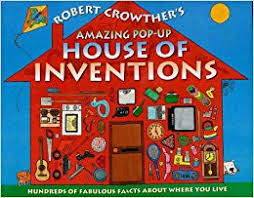Inventor’s Day Pop-Up
Listen to the Recess! Clip
| Author | John Cech |
| Air Date | 2/12/2001 |

Inventor’s Day Pop-Up Transcript
It’s Thomas A. Edison’s birthday today, and it’s also Inventor’s Day — the perfect time for a terrific new book, Robert Crowther’s Amazing Pop-Up House of Inventions.
Each of the five modern rooms in the book is filled with objects (like a workbench, a cabinet, a bathtub , or a sofa) that spring into three dimensions when you open the page. And in each room, there are dozens of flaps, doors, and sliding devices that open to reveal information about such things as board games, clocks or ventilation ducts, as well as such basic inventions as paper, scissors, and soap — which, as it happens, was made by the Phonecians in 600 B.C. using goat fat and wood ash. Mr. Edison’s light bulb is here, in the living room, along with details about the first barometer, video recorder, coil springs for furniture, cellophane tape, popcorn, and the first rugs, which were made from plaited rushes twenty to thirty thousand years ago. When we lift up the rug on the floor of the living room, we find a ring and learn that the wedding ring was worn on the third finger of the left hand by Roman women because that finger was thought to be connected by a nerve directly to the heart. With the living room’s stereo system, we find out, in Crowther’s text that “in 1903 a record made of chocolate was created! It played when the gramophone needle was placed on the grooves of its tinfoil.”
At the back of the book, Crowther includes a double-page spread that provides timelines for “some inventions that changed the way we live” — from the earliest forms of writing which have been found in Iran to the World Wide Web which was devised by Tim Berners-Lee; from the first earthenware pot — which let humankind add boiling to its culinary techniques — to the first genetically engineered food — a tomato — which was sold in America in 1994; from the first known bathtubs that are more than five thousand years old and come from Gaza, to the Jacuzzi, which was invented in the 1950s.
Crowther’s book is more than just a clever piece of paper engineering. It’s a fascinating quest, backward in time, to find the origins of many things that we take for granted in our daily lives. And it passes on the awareness to its readers, child and adult, that these things didn’t just appear. Rather, they were and are part of a long continuum of human ingenuity and creativity — that spirit of inventiveness that is still popping up, all over the place.